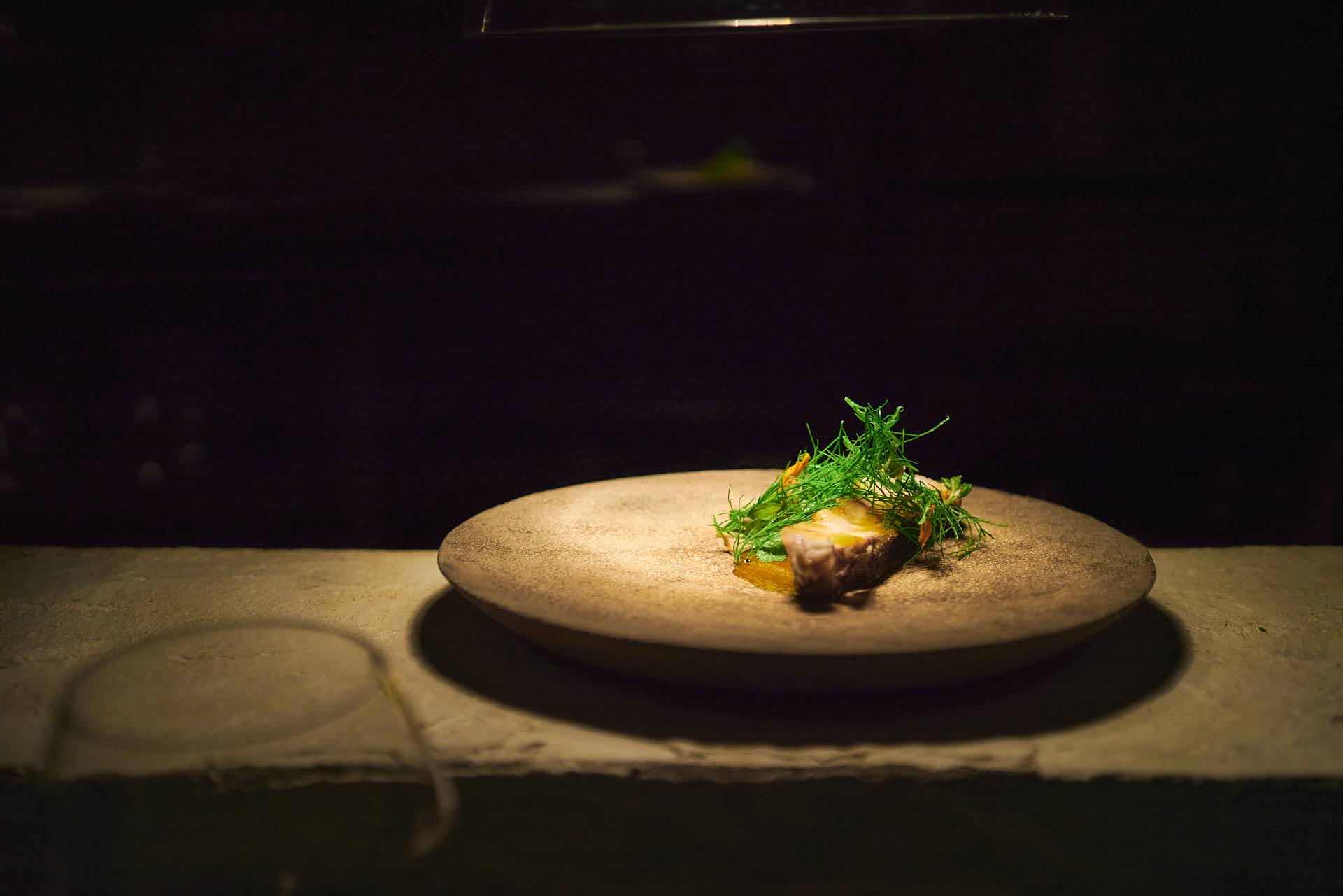In an inconspicuous building located in the central part of Okinawa’s main island, there is a restaurant with only a small counter and five seats. The restaurant is Mauvaise herbe and it is a reservation only restaurant run by Keiji Ojima.
In this somehow secretive little space, people from all over Japan and overseas come to indulge in Ojima’s cuisine.

Ojima’s dishes are made with local ingredients that he personally selected from all over Okinawa. They are prepared according to the season and his individual dishes are uniquely Okinawan.
The paired drinks are also prepared with care and offer a new experience that is uniquely Okinawan.
How does Ojima create his one of a kind dishes? The dining experience that Ojima offers is a shikohin experience of ultimate indulgence and we visited him to explore its essence.
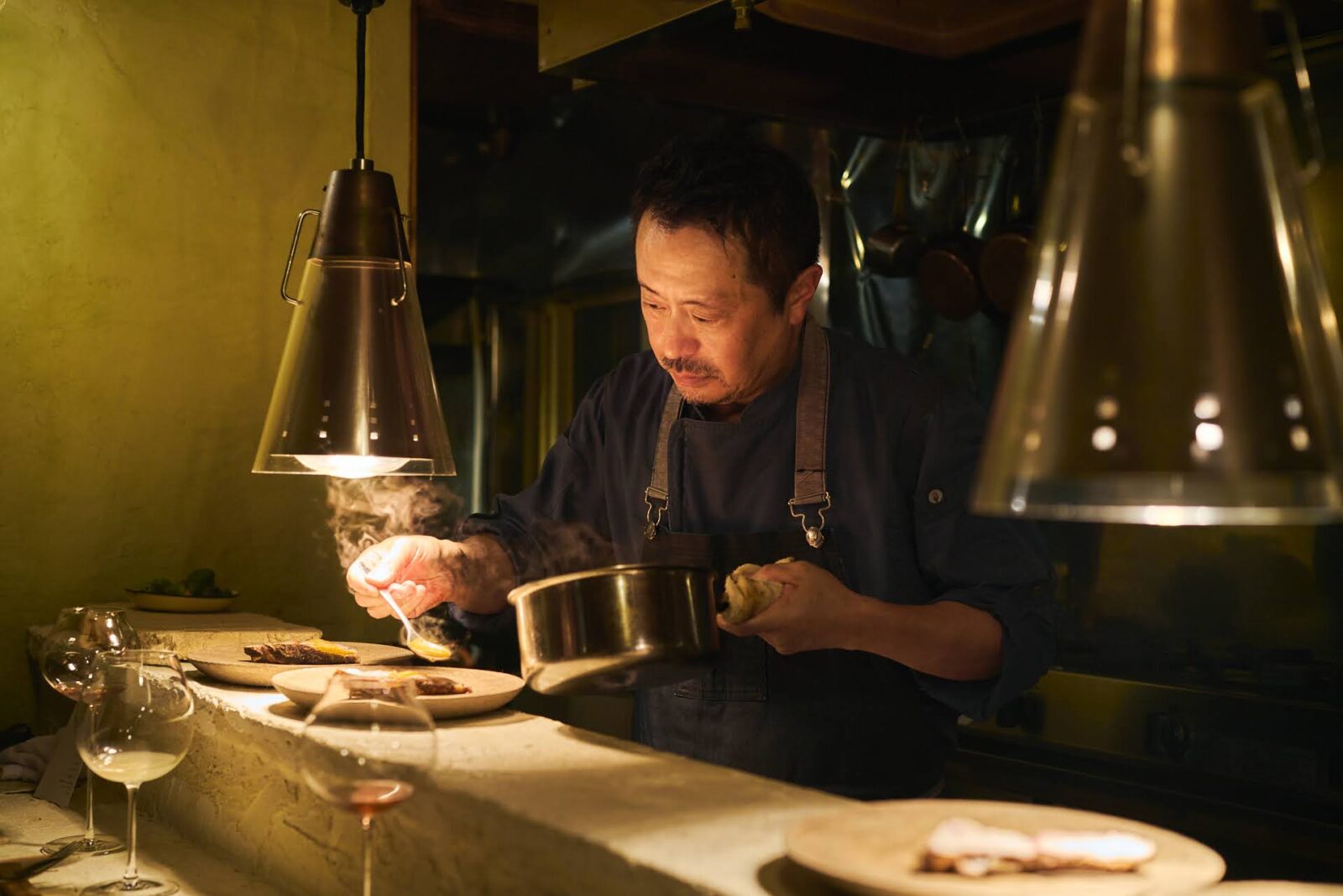
Wild animals, birds, unwanted fish and wild plants make up the flavor of uniquely Okinawan dishes
As I sat down in one of the seats by the counter, I looked around inside the restaurant. In the wooden shelves in front of me there were jars of various sizes filled with mysterious plants. In the refrigerator with a glass door in the back of the kitchen, chunks of aged meat were hung and waiting for their turn to be served.

The room almost felt like a laboratory and the air was filled with a sense of tense excitement, almost like sitting in the audience in front of an orchestra that is about to perform a symphony on the magnificent land of Okinawa.
The conductor is Ojima and he works quietly with the ingredients in front of him. Once in a while he takes care to read the room and moves his hands with precision.
With the exception of some seasonings, all of the ingredients he uses are sourced in Okinawa. The only thing on the menu is the course of the day. There is a small memo placed in front of each seat that lists the dishes on the course.
The list is simple, using just the name of the ingredient such as “root”, “leaf”, “island goat”, “island radish” etc. as the description.
We will introduce a few of the dishes, starting with the first dish “root”.
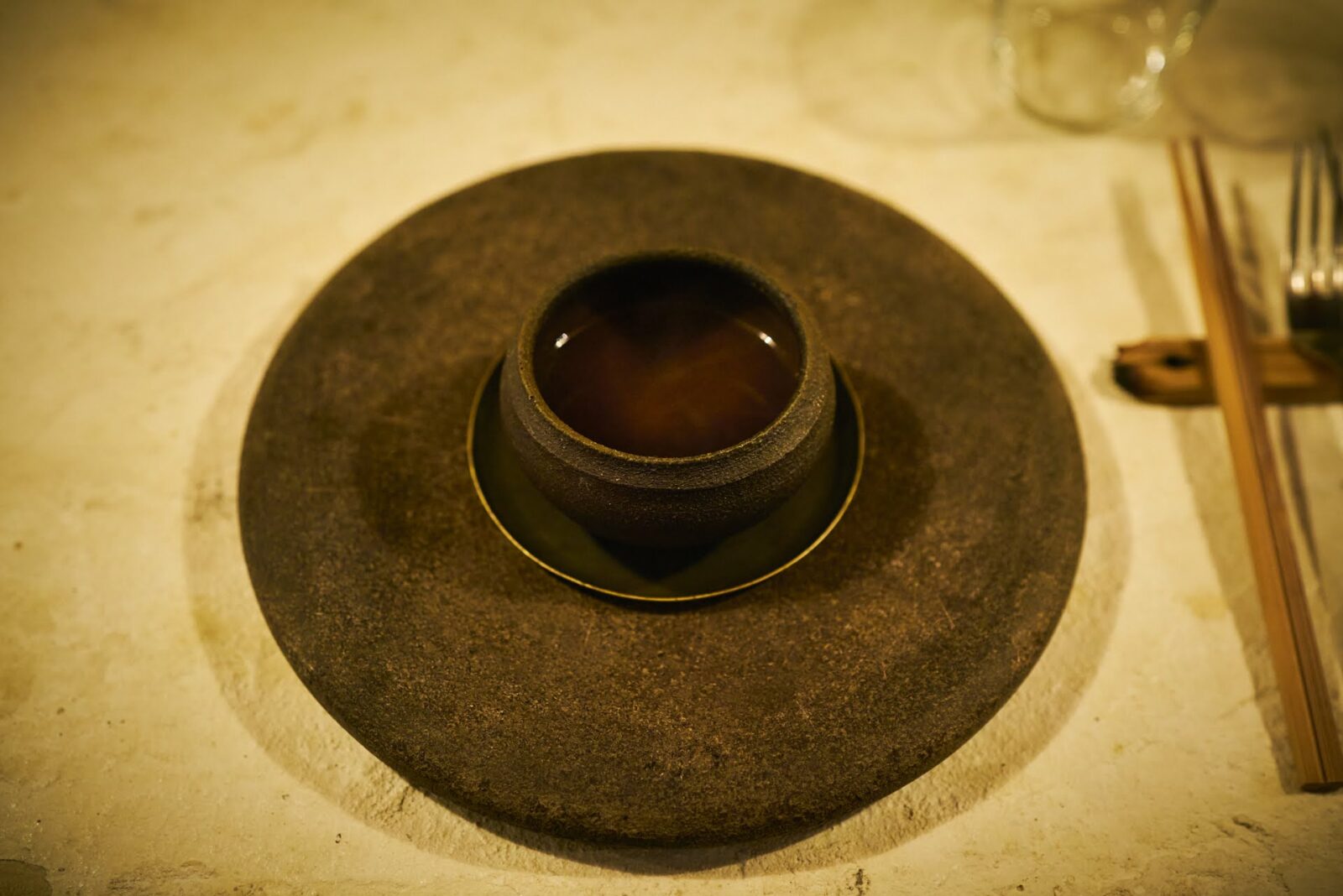
The dish was a warm soup served in a prehistoric looking bowl.
The soup is made up of roots from 10 different vegetables, including romaine lettuce, oak lettuce, leaf lettuce, black island carrots, coastal hog fennel, and more, that have been roasted or sun dried before being simmered down slowly over time at a low temperature on a siphon.
It has no seasonings added to it. Not even salt or pepper. The flavor is earthy and simple.
As you drink the soup it feels like it is slowly soaking into your body, as if it were spreading through all corners of your veins. The bounty of Okinawa’s earth penetrates to the core of your body as you drink this juice like soup.
The next dish, “island goat” was a surprisingly light dish made up of thigh meat and neck skin that has been cured and made into a tartare.
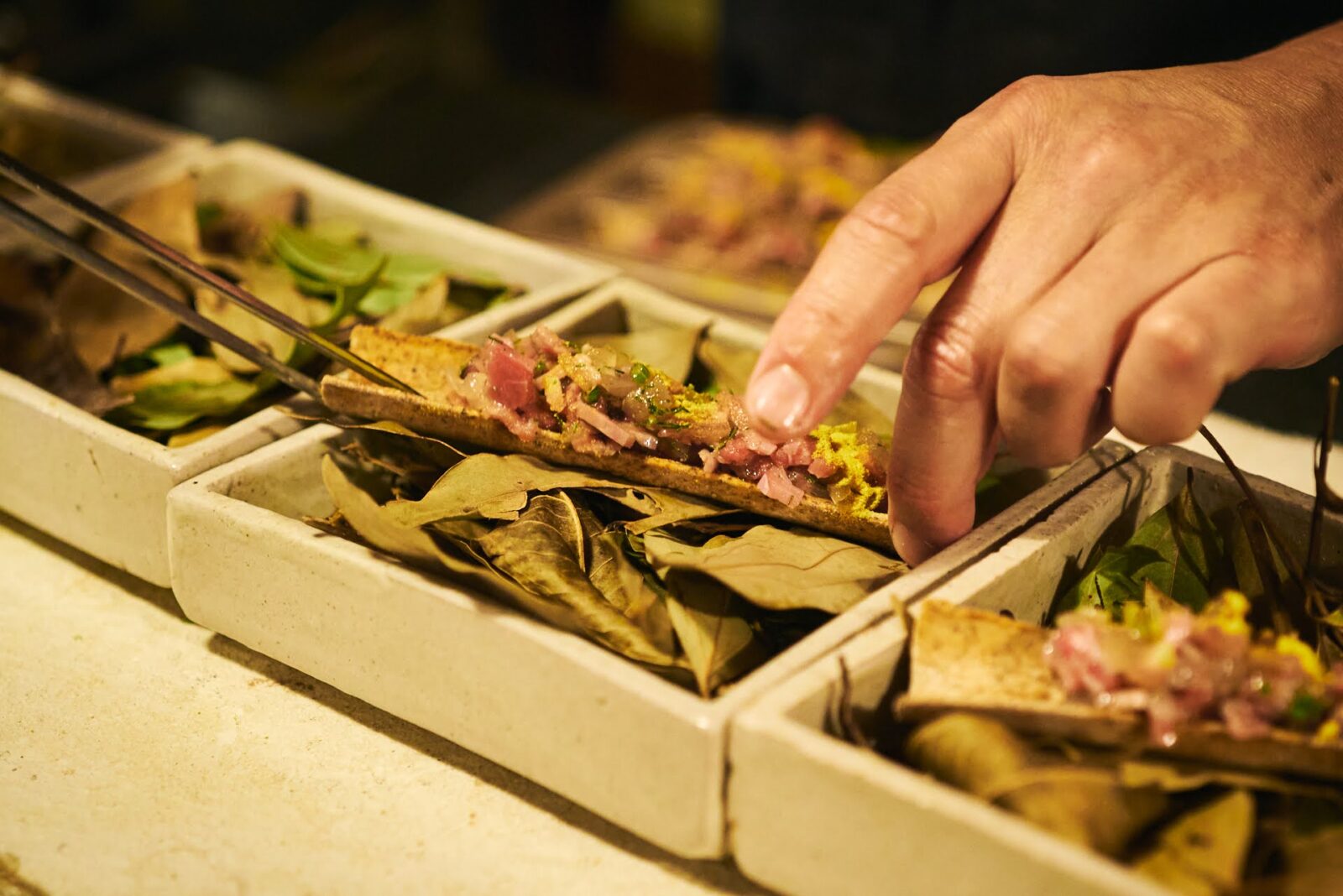
The meat has a deep umami but virtually no odor. Ojima says, “The goats that were eaten in Okinawa in the past did not have any odor.”
More than 90% of the goats in Okinawa today are crossbreds of Western goats which are very large, weighing nearly 100 kg. They make up most of the distributed meat in the market and are characterized as having a strong odor.
The goat meat that Ojima uses are of small island goats that have a long history in Okinawa. They grow to only about 40 kg and are kept in Uruma City along the Tengan River where they live leisurely, eating grass on the banks of the river.
The goat meat has a very clear and fresh flavor with a beautiful layer of fat. Because the island goats are small and relatively difficult to keep, not many are raised anymore.
The next dish was Ryukyu wild boar, white Japanese bulbul, and pheasant. It is served as a paté en croute (a traditional French dish of pate wrapped in a pie crust). Wild boar is native to Okinawa but is considered a nuisance. This dish uses the meat of such wild boar and two species of wild bird.

Although the Ryukyu wild boar are smaller and skinnier than the wild boar on the mainland of Japan, it has a delicate flavor with a hint of sweetness. Ojima accompanies the local hunters on their hunting trips and helps to butcher the catch.
The hunters aim to kill the wild boar with one shot as it is relaxing and eating food. They then quickly remove the blood from its body onsite. Whether the removal of the blood was done well or not has a big impact on the flavor of the meat.
The damage these wild animals cause on farmlands is a big problem in Okinawa and many are non-native species of animals. The white Japanese bulbul and pheasant are officially recognized as harmful species to the local environment.
The next dish was like a piece of artwork made with mabe, a clam that has a uniquely shaped shell.
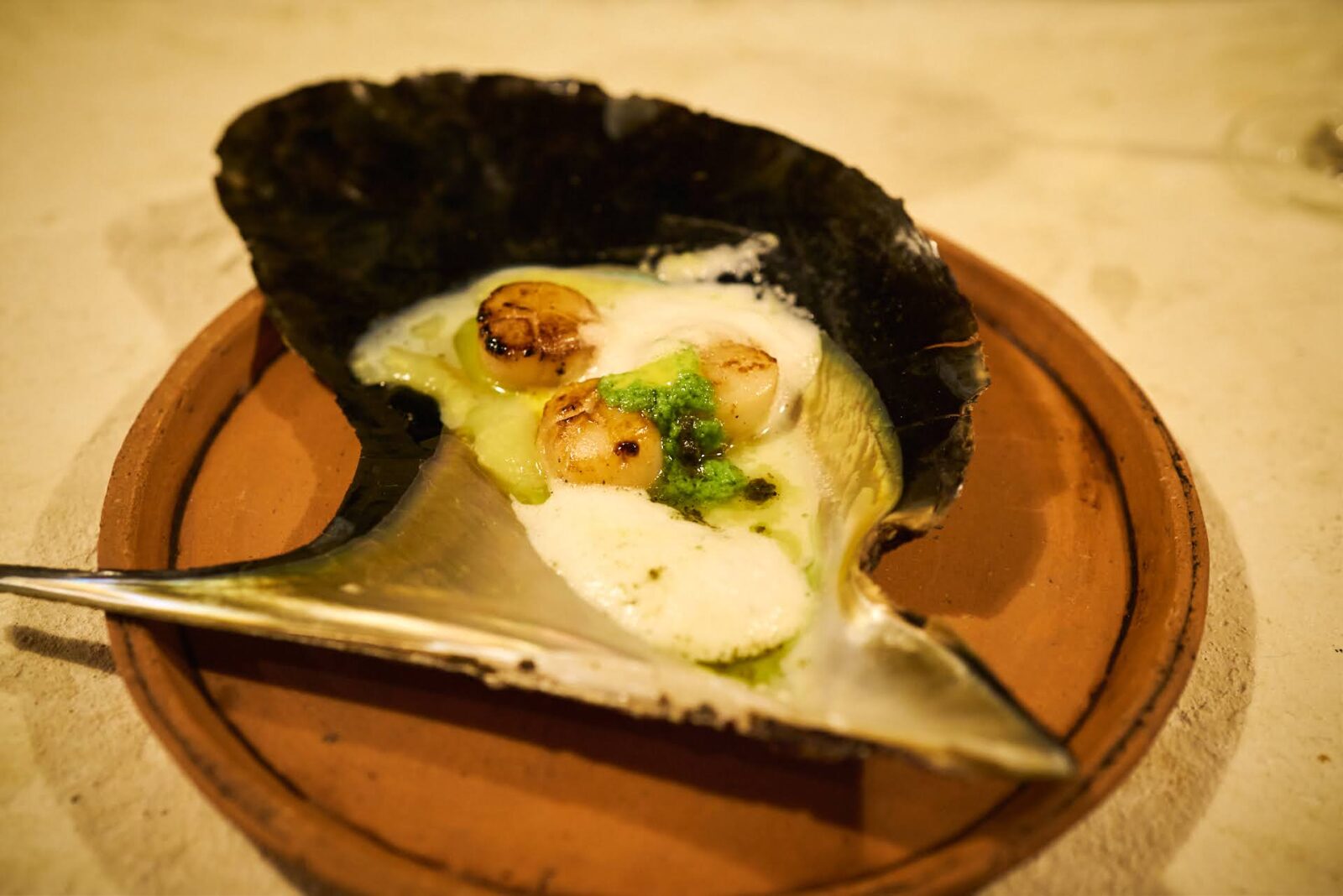
Mabe clams are often used for making pearls and other purposes and are found in Amami Oshima and Okinawa. Most are not meant for eating so it is rarely auctioned in the fish market.
Ojima has been working with fishermen to find ways of using underutilized resources and for the last three years he has worked on finding ways to use mabe in cooking.There are very few edible parts on the mabe, and so far the scallops are the only part that can be enjoyed.
The dish used three scallops grilled over charcoal and served with a leek paste, and clam liver sauce with whisked pinto bean milk.
The scallops have a fluffy texture and are more delicate than the more common hotate scallop. As I was enchanted by the beauty and flavor of the dish, it made me think about the serious problems and challenges the oceans and fishing industry face today.
The volume of fish caught in Okinawa has been decreasing every year due to climate change and overfishing. There are movements towards imposing regulations to protect highly sought after fish such as makubu.
The conservation and management of Okinawa’s unique resources is an important issue and Ojima has been lobbying to address it. The provision of unutilized resources is often unstable and so it makes it difficult to put a price on its value.
Ojima also accompanies fishermen on their fishing trips. He works with them to find ways to enhance the flavor of the south sea fish by teaching them how to paralyze and store the fish to maintain higher quality and helps to add more value to the fisherman’s catch. He also explores ways to utilize fish that do not enter the fishing market into his menu to improve the fishing industry as a whole.
The next dish was a kurodai (painted sweetlips) which was caught using an underwater gun.

The kurodai is cooked on a gentle heat and served just barely raw with only the skin being nice and crispy. It is served with a broth of fish stock that has been boiled down to a thick sauce and garnished with herbs such as young fennel and dill leaves, strawberry mint, calendula and marigold. The dish is beautiful and kind on the eyes. The kurodai meat is plump and has a solid texture and you can taste the sweetness of the fish as you chew.
The next and final dish before dessert was Ayahashi Beef.

The cattle of Ayahashi beef from Uruma city are made up of retired 15 year old mother cows who have given birth 12 times and would normally be put down. The cows are re-nurtured for two years where they are switched to a healthy diet to fatten them up, raised without antibiotics and given plenty of exercise so they develop a more healthy and lean body.
Their lean meat has a rich flavor and is firm and chewy without being too fatty. Ayahashi beef is not usually available in supermarkets, but it is popular among professional chefs.
Ojima served a piece of rump meat wrapped around nabana (rapeseed blossoms) and a pie crust. The sauce was made of fermented beet paste and a thick broth made with Ayahashi beef shank and red wine and garnished with cacao powder, which was once grown in Ishigaki island. The natural and rich flavors of the beef itself melts in your mouth and fills your whole body with ease.

The unique terracotta-like reddish brown plates that the various dishes are served on is made by Nabuko Konno, a ceramic artist in Nago. Her concept is based on making ceramics that can be returned to the earth and she uses locally sourced red clay. The pieces are glazed with pig’s blood and baked at a low temperature of 700℃.
The spontaneity in the texture is comforting and it makes one feel a sense of gratitude for the life that is cultivated by the rich land of Okinawa. The dishes evoke a sense of such divinity.
The terroir of drinks perfected by distillation, extraction and fermentation

Each of the paired drinks in the course meal also provided new culinary experiences.
All the non-alcoholic drinks are handmade by Ojima. The first drink was made and kept in an old earthenware pot which Ojima boldly placed on the counter. Inside was a homemade drink made from fermented kabuchii (a native Okinawan citrus), including the peels and pith of the fruit.
The earthenware pot is made by a local clay artist in Nanjo, Komura Kihan, using local jargal clay. It is an unglazed pot made with an ancient Okinawan technique called arayachi, and it is called a fermentation jar because the tiny holes in the clay allow the pot to breath, making it very suitable for preserving and aging.

For the next drink, lemon verbena and chamomile leaves were distilled to extract aroma and then fresh lemongrass leaves were added to make a cold brew. Okinawa beguu are native blue rush leaves and these are also extracted in a distiller. Fresh leaves are added to the distilled water again and heated at a low temperature to create a slightly red, thick drink. All of these drinks were completely new experiences that I had never had before.
Another drink was made from shell ginger which is kept in a cold brew until the shell cracks and opens up. The juice of ginger and meyer lemon are added and although this drink does not contain anything else, it has a complex spicy and deep flavor that is surprisingly refreshing and aromatic.
Each drink compliments the food while having a gentle yet slightly wild taste. It is as if you are surrounded by the rich wilderness of the Yanbaru Forest.

There was also a surprisingly playful wine on hand which was made from wine by Hirotake Ootaka of La Grande Colline in Okayama. This wine was placed in two fermentation jars made by ceramic artist Komura. One was stored in a cave and the other was buried in the ground and aged for a year, like the ancient Georgian Qvevri wine making method.
The first had a slightly acidic vinegar-like flavor while the latter had a mellow aroma that tasted like marley wine. Both were transformed into a completely new drink.

Ojima is a quiet man that does not say a lot.
However, he chooses his words carefully and expresses what he has to say in a sincere and clear manner. All the dishes and drinks had a feeling of taking a step deeper into the true essence of Okinawa and sometimes one would be struck by the grandness of nature and smallness of mankind through them.
As you savor the magnificent history and stories of Okinawa that are being told through the food, the experience moves your whole body and allows you to develop a deeper interest and appreciation of Okinawa.
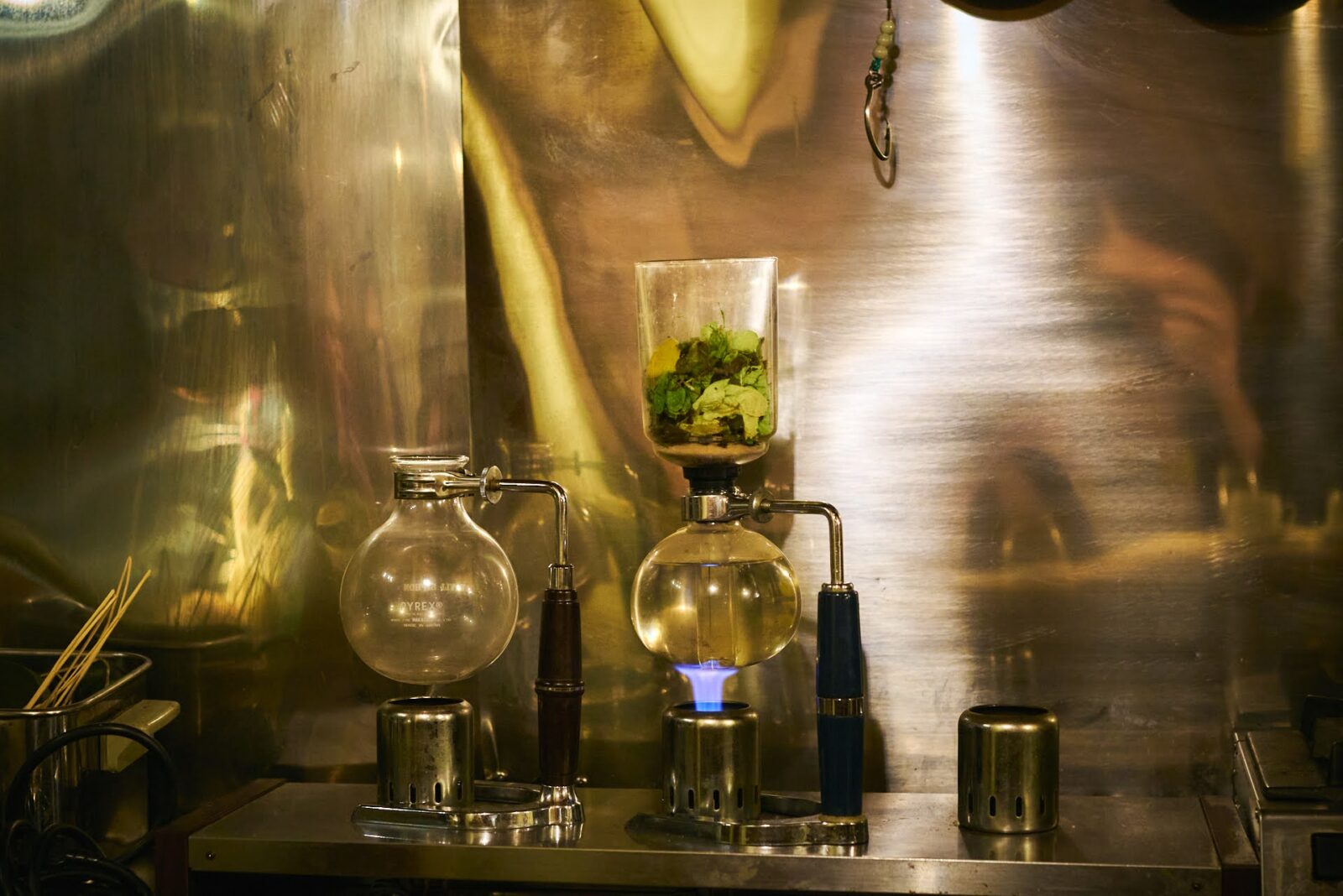
Traveling to France after being disappointed by Okinawan ingredients and culture
Ojima says that he has always loved to travel the world and eat delicious food.
After first working as a salaryman he later entered the culinary world. Ojima says, “I did not really have high aspirations from the start.”
He says that he had a light hearted interest in learning to cook and hoped to someday have his own restaurant, but the moment he started training at a Japanese food restaurant he was “beaten down to the pulp.”
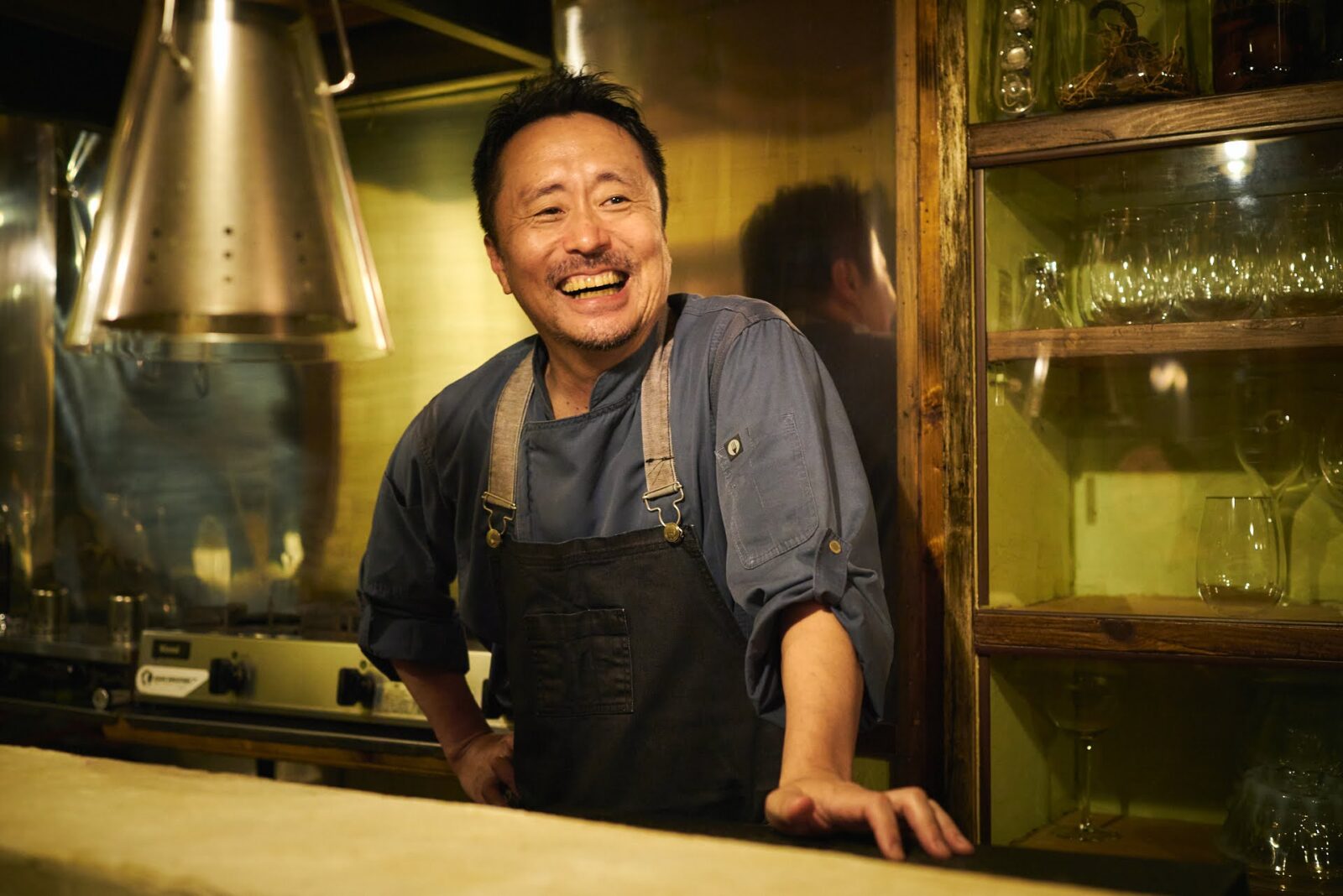
He experienced the harshness of the industry first hand, but by chance he was asked by a French chef to come work for him so he changed direction and began studying French cuisine.
He was drawn to the rich nature of Okinawa and moved there simply because he liked Okinawa. However, when he first arrived he was bewildered by the ingredients and culture and became frustrated that he did not know how to deal with it. Eventually, he gave up.
From there he took a big leap and moved to France where he trained in Paris and Marseille for three years from 1996 to 2002. After that, he returned to Japan.
Learning the importance of traveling to the source of ingredients through butchering wild game
“I always had a sense of regret for not being able to achieve anything in Okinawa. However, when I returned here I found that I could see things differently this time.”
“I felt that this time around I could actually do something here.”
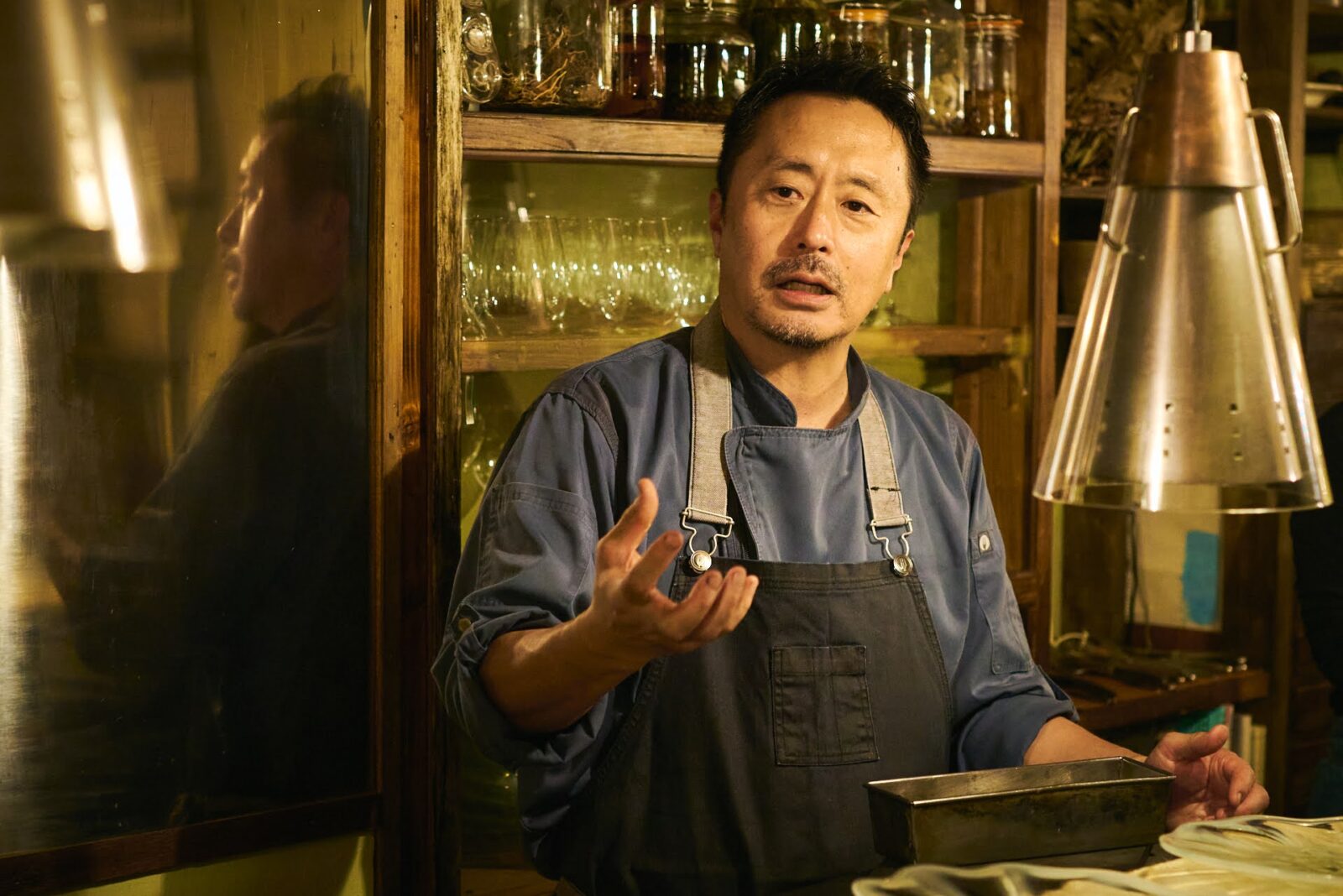
While training in French cuisine, Ojima also worked at a butcher and learned the skills of butchering a cow.
“Perhaps it is different now, but back then the way we butchered meat was very primitive. I would put my hands directly in the cow’s organs and pull them out. The body was still warm and I could still feel the life in them.”
“This experience taught me the importance of traveling to the source of the ingredient, seeing it for myself and touching it with my own hands.”
“I happen to be in Okinawa now, but no matter where I am I want to cherish the local ingredients and make the most of what is available to me.”
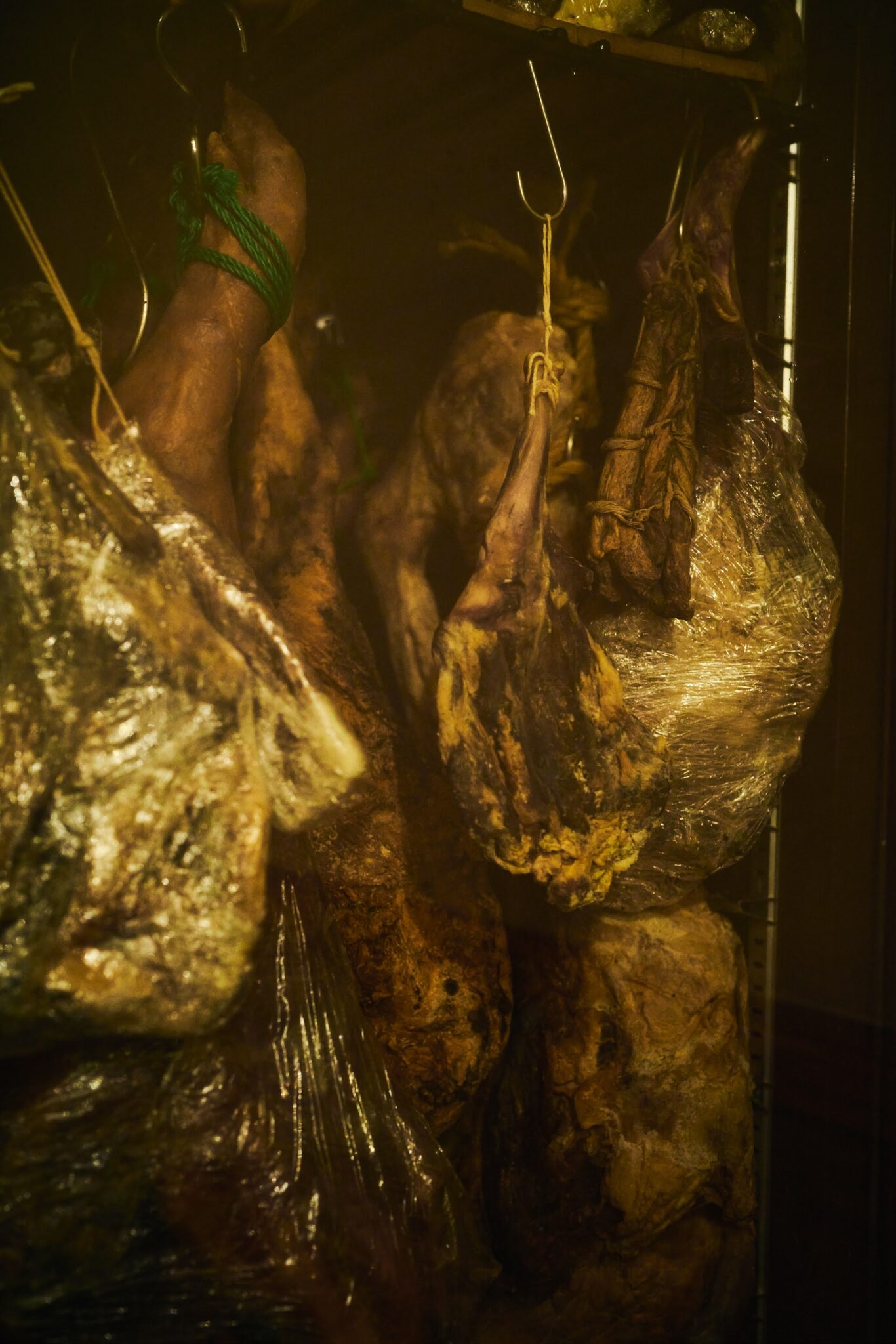
While in France Ojima trained as a chef, worked at a butcher shop and borrowed a space in a kindergarten to open a restaurant and served food to the children there.
Due to the landlord’s circumstances he could no longer keep his restaurant in the kindergarten and was looking for a new location when he was asked to cook as a home chef.
From there, he started getting more catering jobs. Even today, he continues to do catering and works as a traveling chef under the name “Nameless Restaurant”.
He not only has his restaurant in Okinawa, but travels all around Japan and uses local ingredients to serve dishes.
“I am not very good at advertising so I did not get a lot of work at first. It took a long time to get to where I am today.”
Taking time to build relationships with producers
The depth of Ojima’s passion towards his ingredients can be felt with each dish he serves.
He says that his motivation is rooted in his desire to convey the hard work of the farmers, fishermen, potters, and all those who are involved in producing the ingredients for his dishes as faithfully as possible. He says he is not very interested in self expression.

He is also dedicated to conveying the charm of Okinawa and the unique food culture here that makes this special culinary experience possible.
He travels to the mountains and oceans to experience the work of the producers first hand. He works side by side with them to experience their work through his own body and always strives to deepen his understanding. Finally he looks at the ingredients through the eyes of a chef to find the best way to cook them.
He takes his time to build relationships with producers and no matter how close they become, he is always respectful and is aware of his place.
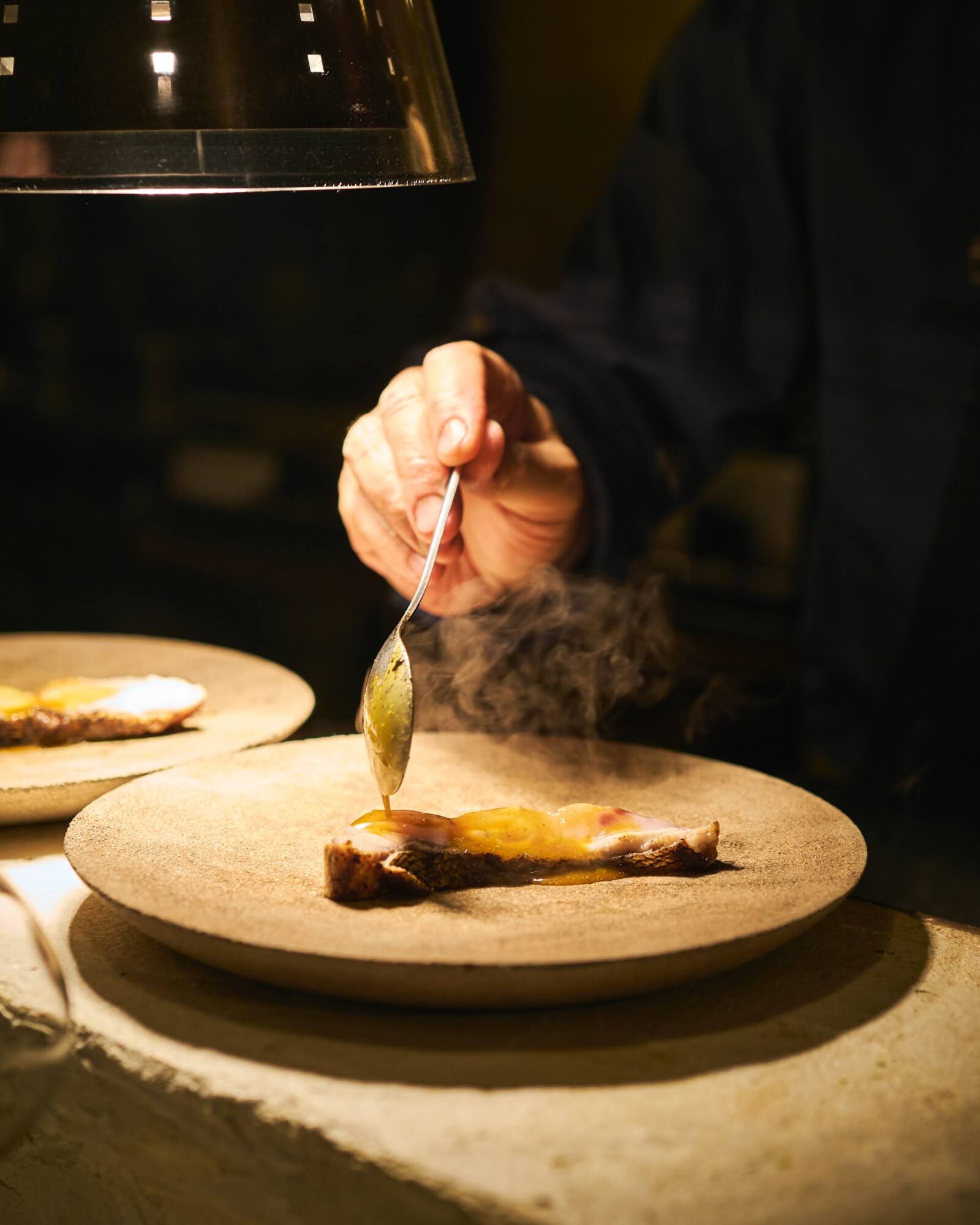
“Even if there is a wonderful ingredient, sometimes it is not handled well or people do not know how to bring out the best of it. As someone who works directly with the ingredients, I find that producers and fishermen are willing to communicate with me and value my feedback. We are also able to create a bond and sense of empathy by spending time together.
“It is difficult to be on the exact same page or feel the exact same way as someone else. However, if I can give a concrete image of what kind of dishes will be possible by implementing a certain process and show that we can form connections in our work together, I think it helps create a shared direction.”
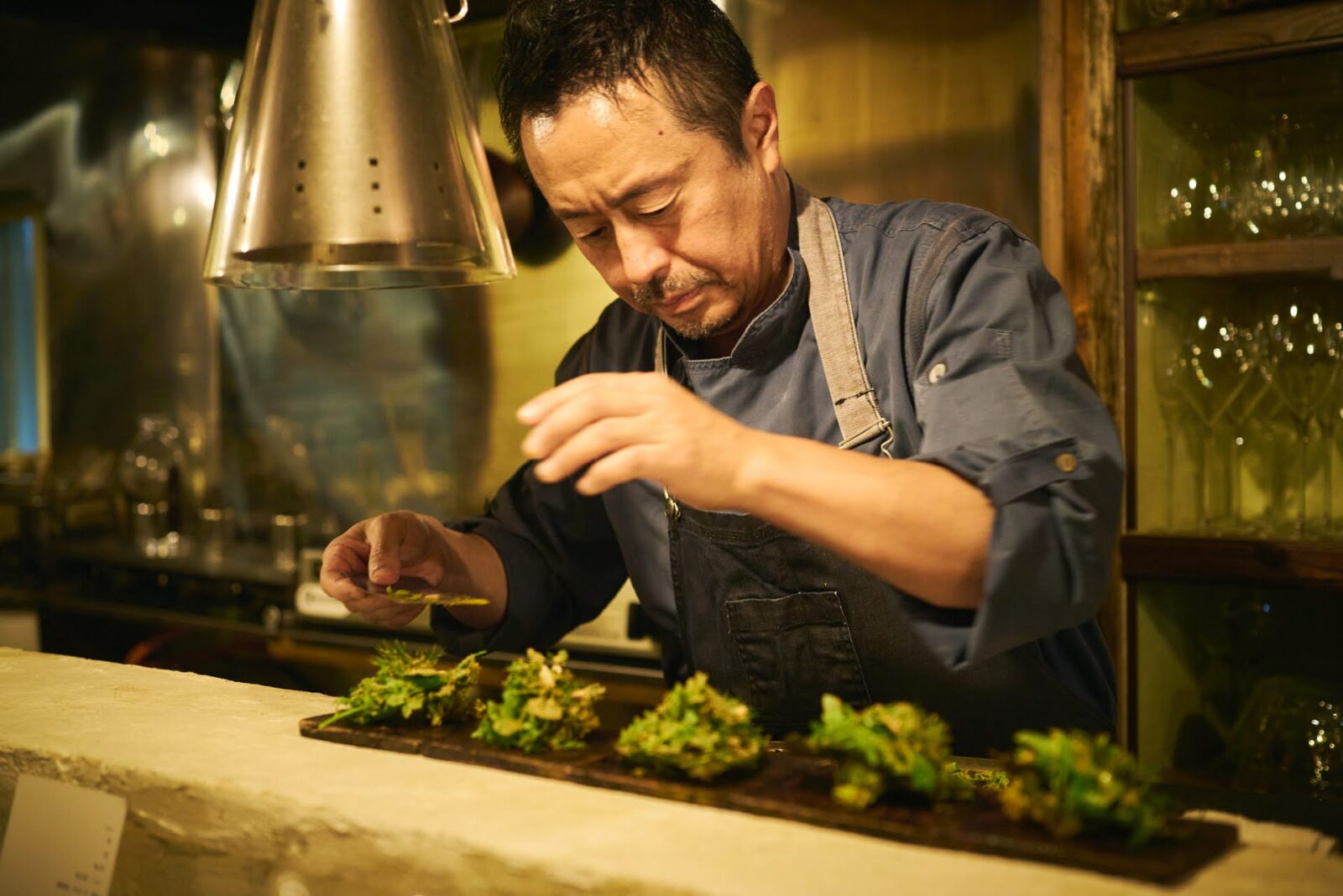
Ojima says, “There are always issues and challenges in the world of food, and even if one issue is resolved there are many more ahead of us.”
The name of the restaurant, Mauvaise herbe, means “a weed” in French. It reflects Ojima’s nature to seek the true essence of things.
Perhaps it is also a reflection of his deep love and gratitude toward the land and his belief that any ingredient can be transformed into a beautiful dish when given the right care and deliberate attention.
All articles on our feature Indulgence and Explore
Advisor to corporations, and local governments on promoting local tourism. Published work includes, “Aomori & Hakodate Travel Book” (Daimond), “San’in Travel: Craft and Food Tour” (Mynavi), “A Drunkard’s Travel Guide: Sake, Snacks, and Tableware Tour” (Mynavi). Her life work is to explore towns in her travels, drink at different shops and visit the workshops of different crafts. Interests include tea, the Jomon period, architecture, and fermented foods.
Editor. Born and raised in Kagoshima, the birthplace of Japanese tea. Worked for Impress, Inc. and Huffington Post Japan and has been involved in the launch and management of media after becoming independent. Does editing, writing, and content planning/production.
